
Try This Dryland Exercise for a Faster Kick (and Faster Swimming)
Looking to get more speed from your kick? Add this dryland exercise to your swimming warm-up before your next all-out kick set.
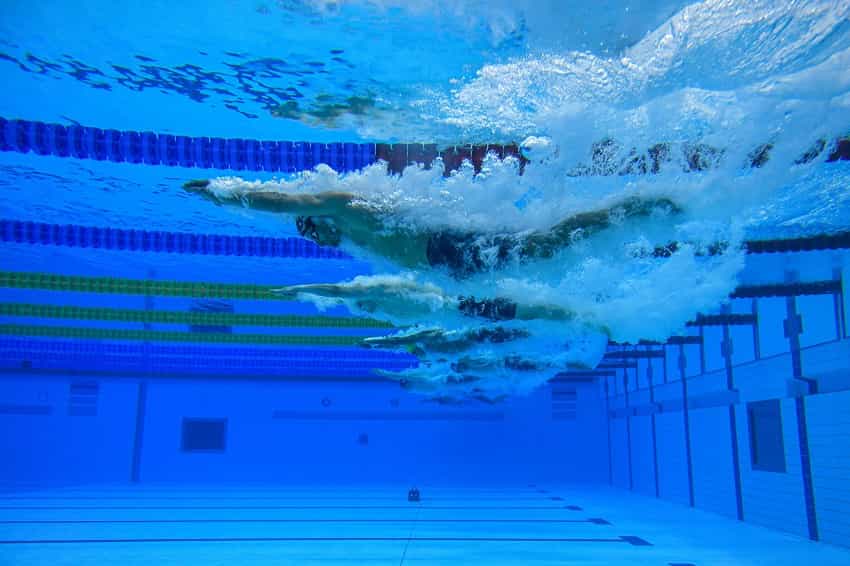
The fifth stroke. Phelps’ secret weapon. The equalizer. These are just some of the things the underwater dolphin kick has been known as over the years. Here is your guide to improving your underwater fly kick.
It’s hard to forget the first time you see a really powerful underwater dolphin kick. When done at top speed, it brings us a step closer to our ocean-bound kin, a seemingly perfect symbiosis of power and grace.
For a few moments, as we snap through the water, we leave land and become something utterly different.
As a scrawny 8-year old in the summer of 1988 I spent every morning and late afternoon cross-legged in front of my parents television as swimmers from across the world swam for glory at the Seoul Olympics. Names like Matt Biondi, Michael Gross, Janet Evans, and Kristina Egerzegyi became firmly implanted in my mind.
In the following years I would always try to emulate my heroes of ‘88. Biondi’s powerful and effortless distance per stroke. Gross’ stoicness behind the blocks. Evans’ never-ending battery life in the pool.
But it was a 5’8” backstroker that left the greatest impression.
In the final of the 100m backstroke the USA’s David Berkoff and Japan’s Daichi Suzuki would swim nearly half of the final underwater, with Berkoff in particular, doing something that became widely known as the Berkoff Blastoff, staying under for the first 35 metres of the race.
It was like nothing I had ever seen.
The underwater footage provided a tantalizing glimpse into the undulating raw power.
It was graceful, it was potent, and it was fast.
At practice I would try my hardest to replicate the feats I had seen on TV. And while my Berkoff impersonation probably looked more like a thrashing salmon in its death throes than the animal for which the kick is named, I was hooked.
In the 1990’s it was the butterfly that became the stroke de jour for the underwater dolphin kick, with Russia’s Denis Pankratov and the United States’ Misty Hyman mastering it in differing styles.
Pankratov would soar underwater like Superman, hands separated in what was almost a sculling motion, defying the logic of the time (and present) of maintaining a perfect streamline.
Hyman, on the other hand, dominated the women’s butterfly events doing fish kicks–underwater fly kick on her side–with both swimmers using their unconventional styles to not only break world numerous world records in the butterfly events, but also bringing submarine dolphin kicking back to the forefront of the swimming consciousness.
After all, until then, the dolphin kick was largely a fringe thing…
Something you had or you didn’t.
Something reserved for the outliers in the sport, who were assumed to have freakish flexibility and iron lungs that allowed them to perform the extended feats of sub-surface piloting.
But then the 2000’s, with Ian Thorpe and his smooth, pulsating breakouts, and more notably, Michael Phelps and his insane walls happened, and something very quickly became apparent…
If you wanted to be elite at any level that you’d have to attain some level of competency in the underwater dolphin arts.
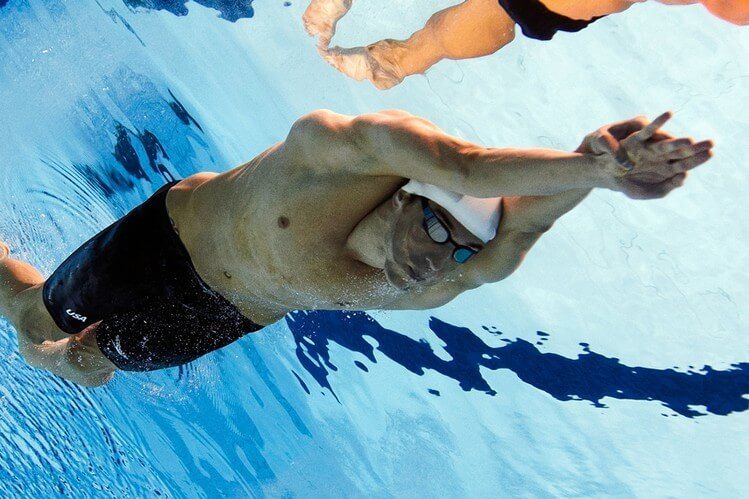
Now, having a solid underwater dolphin kick is a prerequisite for swimmers of every stroke.
It’s become as essential as having a good dive, solid flip-turns, and good swimming technique. The importance of it becomes especially apparent with swimmers who compete primarily in short course meters and yards.
During the late 80’s and 90’s, because it was such a fringe aspect to swimming and because it was fairly difficult to teach, it wasn’t widely taught. As a young age grouper I knew having an underwater dolphin kick would be not only like, super awesome, but it would make me look like a total superstar in the water.
But where to start?
Imitation is one thing, but understanding the mechanics and physical traits necessary to power the kick efficiently and quickly are altogether another.
So that’s where this little guide is going to come in handy for you.
This guide is meaty; it comes in weighing at a solid 3,718 words, but it is action-packed with things you can start doing today to improve your kick and is fairly comprehensive.
Everything in this guide is designed to be actionable and immediately implementable.
The guide covers published research on underwater fly kick (science!), as well as tips from biomechanists, high-performance consultants, Olympic gold medalists, strength and conditioning specialists, and one of the most successful coaches on the planet.
Sounds good?
Alright, let’s dive right on in.

Within this guide to improving your underwater dolphin kick, we are going to touch on 4 areas that all go hand in hand:
At the end of this guide, we will also give you a link to a free PDF version of this article so that you can get started on improving your dolphin kick at the pool starting today.
Alrighty, before we get into the other stuff, it is important to make sure that we have the fundamentals put together. After all, doing hours upon hours of fly kick is only as effective as the technique we use while doing it.
Here are 6 technical considerations to remember about your UDK:
A big ah-ha moment a lot of swimmers have is when they understand that they shouldn’t be just kicking up and down, but that they should be kicking backwards.
When you stop and think about how propulsion actually works, that you want to be pushing the water behind you and not just up and down, it makes you rethink the way you are kicking.
In the same way that we aim to have an early vertical forearm (EVF) with our catch, strive to have an early vertical ankle (EVA) with your kick. This is where having exceptional ankle mobility comes into play.
A more flexible ankle is able to pull further back and “catch” more water.
Remember: the feet are the only things creating propulsion when you are kicking. Your thighs, knees and hips are driving them, but it is your feet that actually are solely responsible for moving you through the water.
When you push off or dive into the water, you are going at the fastest speed you will ever attain in the water. At no point will you ever swim faster. (Maybe one day…)
Most swimmers equate massive dolphin kicks with maximum propulsion. And while you may feel like you are getting a huge amount of torque, you are actually slowing yourself down by creating an inordinate amount of drag.
Strapping on a pair of swim training fins exaggerates this effect so that swimmers actually notice it.
Do a 25m doing small, whip-like kicks for time. And then do a 25 doing the biggest, most powerful dolphin kicks you can possibly do.
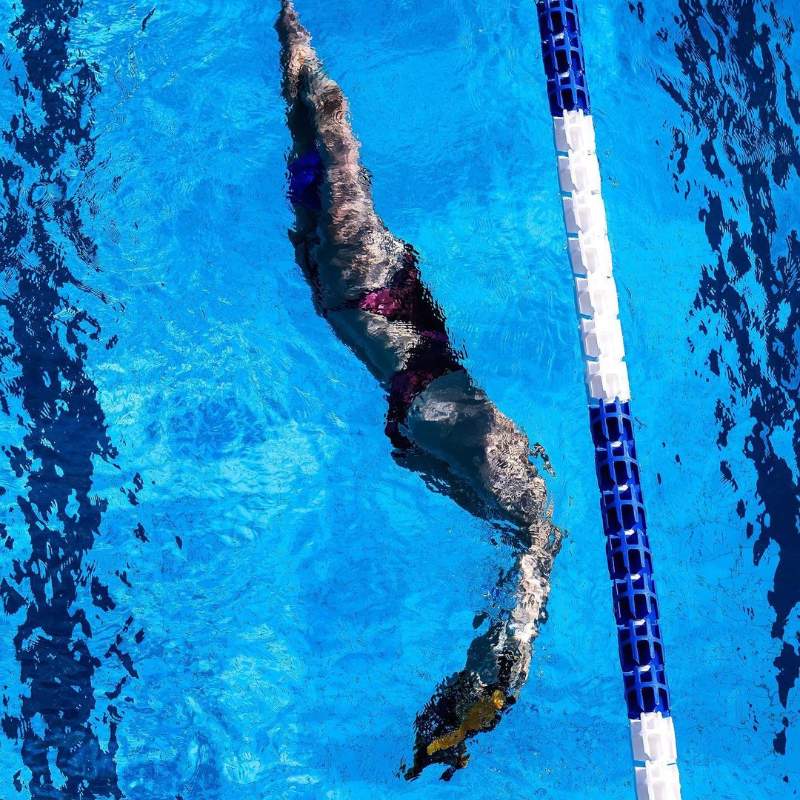
With the wide kicks you will find that although you can drop a ton of torque into the kick the drag you are kicking up (pun intended!) is negating the extra thrust.
For a fast underwater dolphin kick, kick fast and kick small.
Remember: Your underwater dolphin kicking isn’t about generating speed—it’s about holding on to the speed you generate off the start and turns for as long as you can. Think of a Ferrari cutting through the water versus a big Mack Truck.
A shocking number of swimmers kick only from their knees. Not only does this tend to create a lot of drag – with their knees pumping up and down like the cranks on a locomotive – but it is also wildly inefficient. When we kick from our knees we leave out the white-hot engine that is our core.
Think of your midsection as the power plant to your kick.
Your whip-like kick starts from a braced core (suck in your belly button and squeeze your butt-butt), and undulates to the very tips of your toes.
A simple way to visualize the role that your core plays is to think of your body as a whip. Your core is the handle, where all the power comes from, with the tail of the whip being your quick-snapping feet and toes.
Mel Stewart, the 1992 Olympic champion in the 200m butterfly, recognized the power that was held in the core area long before core work became a buzz word in fitness circles and on pool decks.
Stewart took his cue from David Berkoff, who had a core that was built of steel, working relentlessly on developing a strong mid-section. In the run-up to his gold medal performance in Barcelona, Stewart hammered his core.
In the Olympic champion’s own words, to get that vaunted mega-kick, “make your athlete engine, your core, a nitro powered monster.”
Remember: Picture a whip when you are kicking– the handle is your core, the tail of the whip your feet.
When setting up your kick, remember that the extension of the kick should be completed in front of your body.
Russell Mark, a USA Swimming National Team High Performance Consultant, former competitive swimmer with a background in aerospace engineering (literally a space scientist!), has done a fair amount of research on the underwater dolphin kick.
His two key focus points for developing a more powerful kick include:
The following image shows what Mark means when he says that:
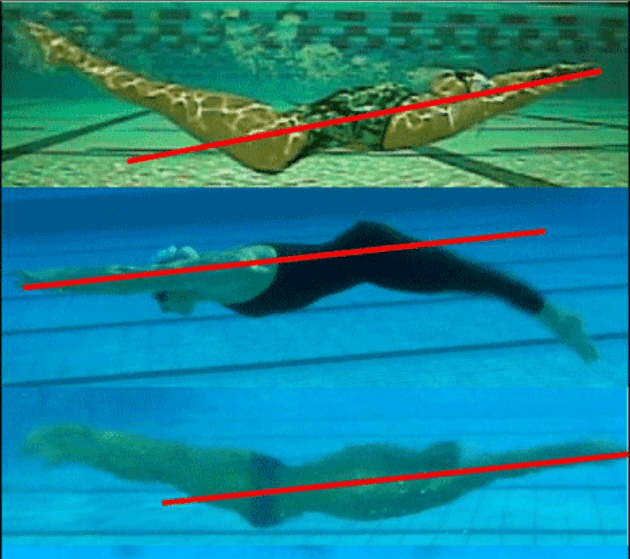
Notice that in all three cases that the swimmers’ respective kicks complete the down (or up, in the case of the backstroker) kick well in front of their body. Doing so allows the swimmer to use the strength and power of their quadriceps in delivering the kick.
Remember: the execution and follow-through of the kick should take place in front of your body.
Dolphin kicking, especially as you become more proficient with it, should be done quickly. Your toes and ankles should snap up and down quickly. When you watch the elite sprinters off the starts and walls they snap their feet up and down so quickly it melts into a bubbly blur.
All too often I watch swimmers pause at the top of the kick for a brief moment, as though resetting themselves. Or pausing at the bottom to glide through their kick.
Ryan Atkinson, a biomechanist at the Canadian Sport Institute Ontario (B. Sc and M. Sc.), a strength training specialist and coach (CSCS and NSCA) and former competitive swimmer, backs this up.
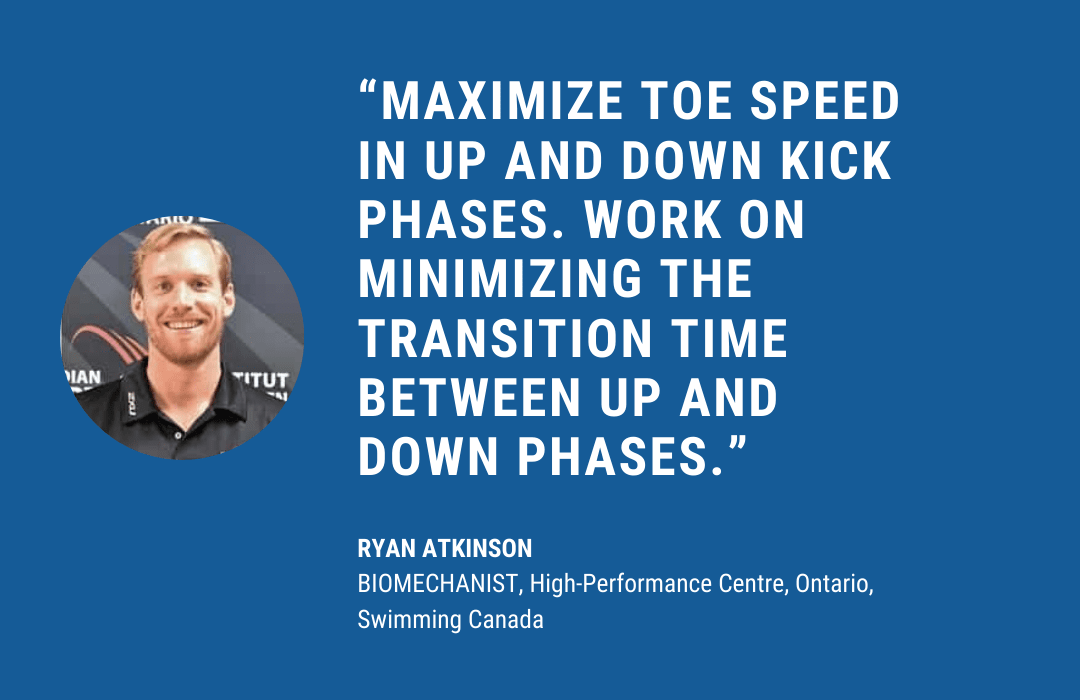
Remember: You want a seamless transition between the up and down phases of your kick, and you want your toes to move like they are running late.
Using your up-kick takes concentration and work, especially if you have never used it before. Although the up-kick serves as a set-up motion for the down-kick, it can also serve as a means for creating propulsion.
Gary Hall Sr., two-time Olympic medalist (and flag bearer at his second Games) and founder of the legendary Race Club, has worked with his fair share of sprinters over the years. From his son Gary Hall Jr., to Nathan Adrian, Roland Schoeman, Mark Foster, and butterfly ace Mike Cavic, Hall has coached some powerhouse swimmers over the years.
We asked him to chime in on what he thought young swimmers could most improve when it came to their underwater fly kick:
“With respect to improving underwater dolphin kick, without writing a dissertation and with respect to biomechanics, I have found that the two most important elements missing in most swimmers are the tendency to kick from the knees, rather than undulate from the hips, and the absence of a forceful up kick.“
A favorite of Hall’s drills to help improve the balance is to perform the dolphin kick while on your side (aka fish kicking), which forces you to use the up-kick.
Remember: the up-kick isn’t just for setting up your next big dolphin kick, it can also be used to generate a little more propulsion through the water.
To summarize what you should focus on in terms of technique:
Unsurprisingly, most swimmers have mediocre ankle flexibility.
There are a couple reasons for this…
The first is that we believe that because we have naturally inflexible ankles that we are predestined to always have them.
And secondly, as swimmers, we are so transfixed on our shoulders – and rightly so – that we often neglect other parts of our body that need some of that stretching TLC as well.
Just how critical a factor does ankle flexibility play?
In a study done of a group of NCAA Div 1 women swimmers, in tandem with a group of recreational swimmers, found that ankle flexibility was directly related to kicking speed.
More importantly, the study found that there was no correlation between how vertical jump power, or even body size when it came to fast kicking, something that should come as a comfort to those swimmers that aren’t 6’5” and built like a power forward for the Chicago Bulls.
Olympic fly champion Stewart backs this up.
“Something that always gave my dolphin kick an edge was ankle flexibility. I stretched my ankles every day, before practice, at home watching TV. If you saw me out on a Saturday night, and I was standing there talking to friends, eventually you’d see me curl my foot over and stretch my ankles. I did it nonstop.”
Here is my five-point plan for getting loosey-goosey feet:
1. Lacrosse ball to the bottom of the foot. Either standing or sitting, depending on how tight the muscle and fascia are, take a lacrosse ball and place your body weight on it. Apply enough pressure so that it is uncomfortably comfortable, but not overly painful. Doing this will also have the bizarre, yet awesomely nice, effect of improving your hamstring flexibility as well. Spend 2-4 minutes on each foot, rolling from the bottom of the toes to the heel, to the edges of the side of the foot. (If you’ve never done this before start with a tennis ball.)
2. Foam roll calf. If you have access to a foam roller – you should, I swear by mine – use it to roll out your calves. Roll up and down the full length of the calf muscle, making sure to get both sides of the calf muscle. Hit it for about 45 seconds per side, spending an extra few moments on any sticky or tender spots.
3. Ankle rotations. As a swimmer, you are no doubt comfortable with arm and leg swings. Over the years we have built up a repertoire of arm swings that help loosen up our shoulders, back, and chest. Now you can add ankle rotations to the list. Using your big toe as a pointer, do 15-20 circles with your foot in each direction. You can add ankle rotations to your foam rolling if you are pressed for time as well.
4. Wall lean stretch. This is a classic stretch, and one that you have mistaken for being an exclusively calf-stretching posture. Facing a wall, plant your foot so that your toes are pointing upwards, heel on the ground, and lean forward.
5. Ankle rollers. The money maker. I never really liked this stretch because for years I had a blockage in my left ankle that made it somewhat painful. However, there is no disputing how effective it is. Sit on your ankles, and slowly rock backward until your knees come off of the ground. Hold for 1-2 minutes. You will notice sizable improvements after doing this for as little as a week or two.
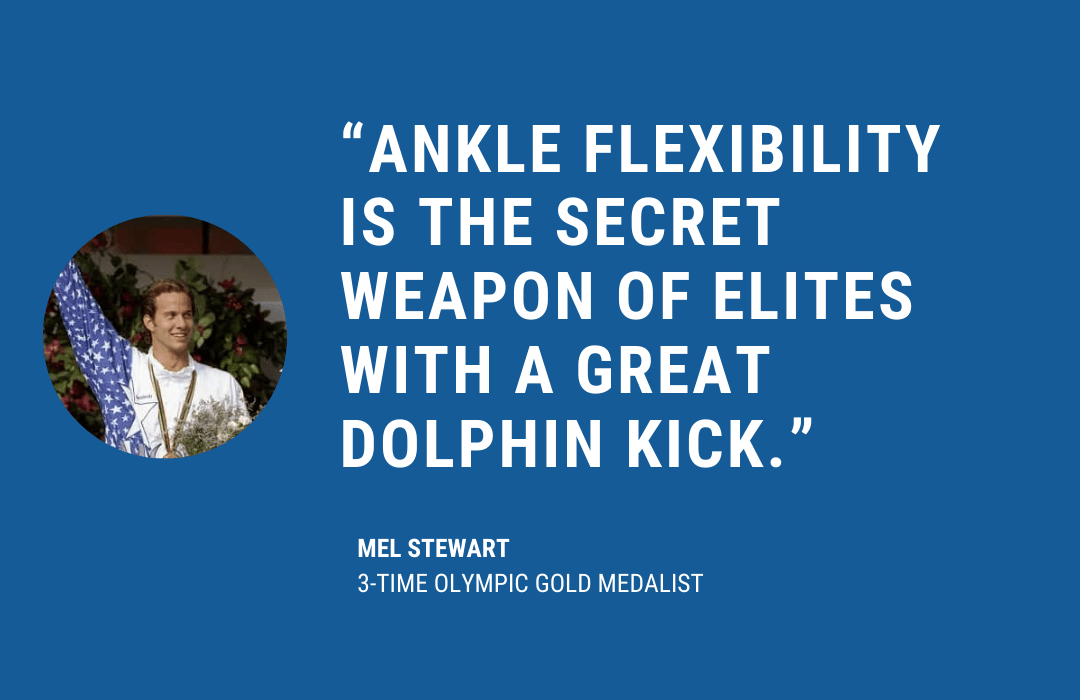
How many times have you actually thought about your ankle strength?
Unless you are rolling your ankles every time you go for a job or play basketball or walk down the sidewalk probably next to never.
After all, we don’t often think of the ankles as something that we need to strengthen. You don’t often hear athletes saying that they are going to the gym so that they can wail on their biceps, lats, and dorsal flexors.
Ankle strengthening isn’t something that usually features in our dryland training workouts.
But as it turns out, a recent study done on competitive swimmers showed that not only did ankle flexibility play a role in the velocity that competitive swimmers were able to achieve with their dolphin kick, but that ankle strength also played a significant role in how fast the swimmers were able to kick.
If you’ve ever had a coach who recommends that you add skipping to your dryland regimen there is a good reason for it–skipping jump rope is a simple way to not only improve the short twitch capabilities of your lower body, but it’s also awesome for building ankle strength in a low-impact manner.
Instead of strapping some dumbbells to your little ankles, just pull out a trusty rubber band and belt out this 4-way ankle strengthening routine that will not only help you kick faster and stronger, but also make it less likely you bail like Bambi on ice the next time you go trail running:
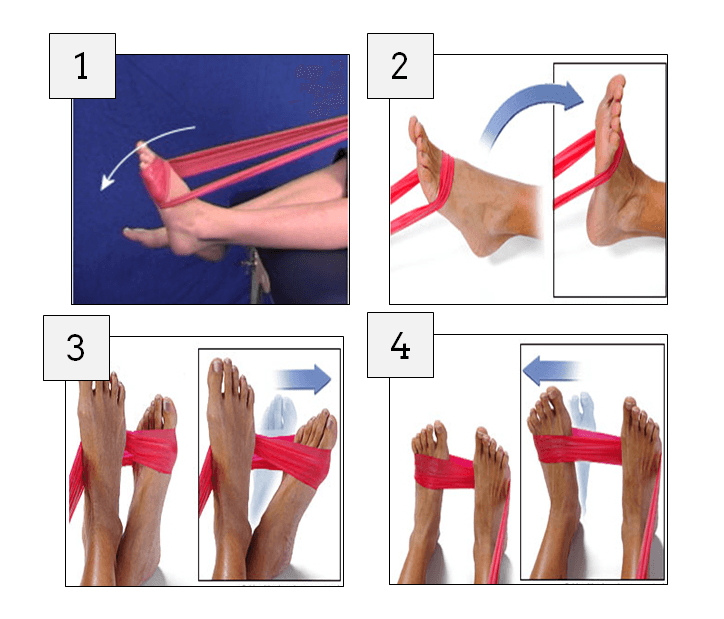
Alrighty then..
We’ve talked about improving technique, flexibility, and strength.
Now, to put it all together. It’s time to put this knowledge to work and actually implement it into your training.
Here are three ways to make the transition from guppy to killer whale a little more straightforward:
In a previous post, I shared with you some of Tom Shields’ wisdom for how to develop a killer underwater dolphin kick.
What it boiled down to was that he simply made it part of his swimming, from warm-up, to the main sets, to warm-down. Shields developed a thunderous underwater dolphin kick by making it a regular fixture of his training, not something that he only worked on at specific points of his workout.
If you are starting from a place where doing a couple of dolphin kicks off each wall is challenging, start small.
Do it off every second wall during warm-up and warm-down. Use open turns if you have to. Don’t beat yourself up if you aren’t starting off by doing 10 kicks off each wall—we all have to start somewhere.
A common problem that arises is swimmers cannot hold their breath long enough off the walls (or more commonly, are under the impression they cannot).
An easy way to fix this is through breath-control during regular swimming. Just from personal experience, I found that when I was doing breath-control work (breathing every 4-5 strokes) I had very little difficulty doling out 4-5 dolphin kicks off each wall.
Contrasted with when I was breathing every 1-3 strokes I found myself stretching to get 3-dolphin kicks off each wall. You kill a few birds with one stone by breathing a little less—you train your body to be able to handle oxygen deprivation and learn to teach your lungs not to freak out when holding your breath.
I love vertical kicking. Nope, I lied. I don’t love it. But I do love the results that I get with it.
You can do high powered underwater dolphin kicks for longer, while also stressing both the down and up-sweep of the kick.
There is an endless variety of difficulty and resistance that can be applied as well: use swim fins, hold a weight over your head, weight belt, do explosive dolphin kicks off the bottom, while also doing it in a streamline or not.
Tack on an extra 5-10 minutes of vertical kick at the end of your workouts and you will quickly see dividends of this relatively small investment in your underwaters.
I would like to give a big thank you to the following for taking the time to share their expertise and experience to enrich this guide:
You can download this post as a handy checklist (yes, for free), as well as a couple BONUS sets that are specifically designed to help you improve your UDK.
Click on the image below and enter your email address to get instant access to the checklist, sets, and a faster underwater dolphin kick!
Subscribe to the YourSwimLog.com newsletter and get tips and advice on how to swim faster every weekday morning, straight to your inbox.
Join 33,000+ swimmers, coaches, and swim parents learning what it takes to swim like a boss.
Unsubscribe anytime. Email will never be shared or sold.

Olivier Poirier-Leroy Olivier Poirier-Leroy is the founder of YourSwimLog.com. He is an author, former national level swimmer, two-time Olympic Trials qualifier, and swim coach.

Looking to get more speed from your kick? Add this dryland exercise to your swimming warm-up before your next all-out kick set.

Dive into a perfect freestyle hand entry with our guide to faster, more powerful freestyle swimming.
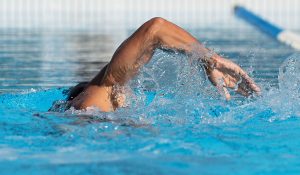
Curious whether laps and lengths are the same in swimming? Here’s a deep dive into how they are essentially the same thing with some key differences.
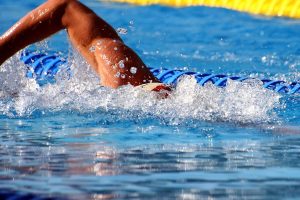
Swimming fast teaches speed, improves confidence, and sharpens competitive instincts. Here’s why swimmers should go fast daily at the pool.
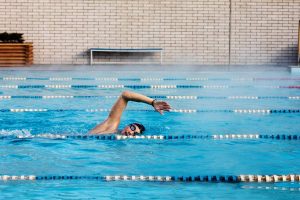
Looking to track your swim workouts? Here are the five best ways to monitor your swim training.
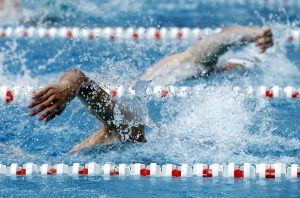
Looking for a swim workout to dust off the speed in the early stages of the swim season? Give this session, which focuses on easy speed, proper body positioning, and overspeed swimming a try.

LANE 6 PUBLISHING © 2012-2024 · PRIVACY POLICY · RETURN POLICY · TERMS OF SERVICE · AFFILIATE DISCLOSURE